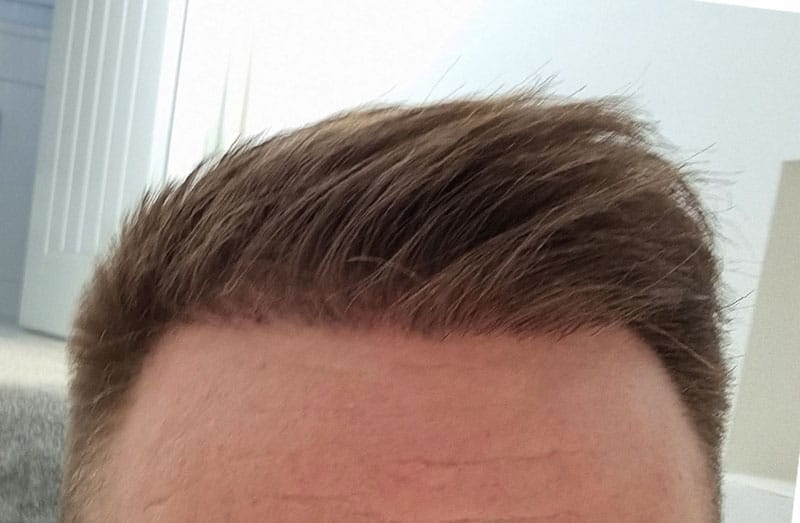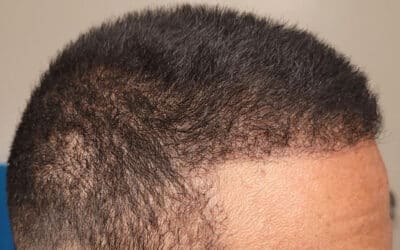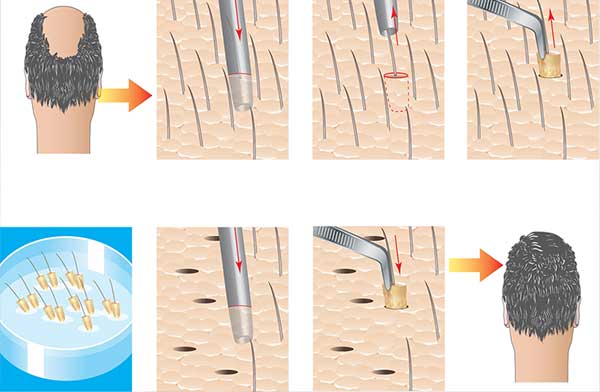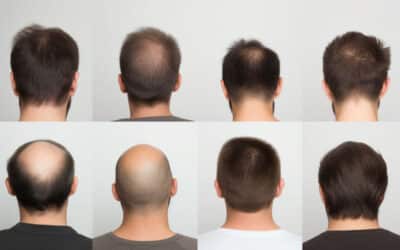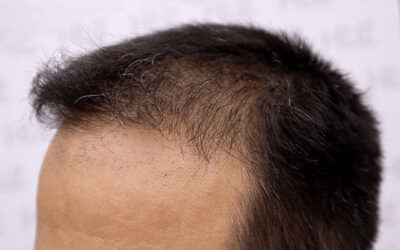It happens generally on a dark and lonely night. The wind is howling through the outstretched branches of a dead and dying tree outside your window while hateful thunder crashes in the distance. You look in the mirror and you know… you have to do something to fill out your thinning hair before it’s too late. We have all dreaded that moment would come, even if you don’t have thinning hair or baldness in your family.
Fortunately for all of us, filling out thinning hair isn’t as difficult as it used to be in the past. There are many different options to fill out thinning hair nowadays than there was back in your father’s generation. Back in those days the one and only standalone option was the hairpiece. The good old toupee which was the long-running joke in all the movies and TV shows back then is a thing of the past. We have all seen those old clips depicting the middle-aged vacuum salesman getting caught in a storm with his hairpiece flapping in the wind with the laugh track running in the background.
Do You Need to Fill Out Thinning Hair?
The options today to fill out thinning hair are numerous, and the technology and medicine behind the hair restoration industry have progressed exponentially since the day of the hairpiece. Today the options to fill out thinning hair can be almost overwhelming. After all, there are so many options and techniques to choose from. The best bet for nailing down a specific approach is to familiarize yourself with all the current techniques and procedures so that you can make an educated decision based upon your own expectations and needs.
The internet can unfortunately be a very confusing place with a tremendous amount of conflicting information. Just simply googling “fill out thinning hair” will inundate you with hundreds if not thousands of websites selling surgery, makeup, sprays, and an almost infinite number of other products and services. So where do you start? Well, you start at the beginning my friend, and at our blog here at Best Hair Restoration.
Follicular Unit Extraction (FUE) Hair Transplant Information
One of the most popular and effective ways to fill out thinning hair is by the follicular unit extraction (FUE) hair transplant. FUE is a process where surgeons will use micro punches to extract single, individual hair follicles and transfer the hair follicle to another area of the scalp. A micro punch instrument is a tool used by surgeons that can create tiny incisions where hair follicles can be removed, transferred, and implanted. Using these types of instruments dramatically reduces the scarring that can occur from harvesting and implanting hair follicles.
Today the FUE technique is one of the most popular ways to fill out thinning hair. However, this has not always been the case. The first doctor in the United States to attempt a hair transplant was a dermatologist named Dr. Norman Orentreich in 1952. Of course, back in the 1950’s doctors did not have access to the modern medical knowledge and technology that they have today. Back then, Doctors harvested large patches of hair from the back of the patient’s head and implant them onto the bald and or thinning spots of the scalp. This technique was the birth of the hair plug.
Hair Transplant History
Back then, this was cutting-edge technology. It was the magic of science giving full heads of hair to the bald, something that most of the bald unfortunates back in those days never would have thought possible. Unfortunately, even if a decent hair plug job looked ok at first, very quickly they would end up looking unnatural with tufts of hair sticking up at different angles with large gaps between them. The spaces between the graphs would be much larger than the normal spaces between natural hair follicles. It didn’t look right and added to the already unnatural appearance.
Prior to 1952, the Japanese were pioneering hair transplants as early as 1930. A Japanese dermatologist named Dr. Okuda was the first to perform a hair transplant in an effort to help people with scalp injuries and burns. Doctor Okuda extracted round sections of scalp that had hair, and implant that scalp onto the injured areas with the hopes that they would take root and grow new hair. Some say Dr. Okuda’s technique of transplant was even more successful than Orentrich’s. However, due to the seclusive nature of the 1930 Japanese culture, not much science was exchanged between the two countries at that time.
The History of Follicular Unit Transplantation (FUT) to Fill Out Thinning Hair
The modern procedure to fill out thinning hair was invented by Dr. Bobby Limmer. Dr. Limmer literally changed the hair restoration game by pioneering the process of micrografting individual hair follicles instead of the large plugs of hair previously used by hair transplant specialists. This procedure is known as follicular unit transplantation (FUT). The FUT process involves a stereomicroscope to dissect a strip excision into individual hair follicular units. Dr. Limmer was the head honcho at the Limmer Hair Transplant Center in San Antonio Texas up until his retirement in 2014.
After the success of Dr. Limmer and the FUT technology, the FUE hair transplant technique became a very popular way to fill out thinning hair. While the FUT process is at times called strip harvesting, as it is a much quicker way to harvest the hair follicles, FUE is a slower and much more precise method. The FUE process takes an extraordinary amount of time to perform and the skills needed to perfect this process is held to the highest standard. (Rassman & Bernstein, 2008).
The Differences Between FUT and FUE Hair Transplants
The benefits of the FUE far outweigh the drawbacks. For instance, the recovery time from a FUE procedure is dramatically less than a standard FUT procedure. This in turn means there will be much less pain after the procedure suffered by the patient. This fact alone is generally a great selling point for the procedure. Also, there is always a risk for long-term nerve damage with any surgical procedure. The same holds true with procedures to fill out thinning hair.
The risk for nerve damage with the FUE approach is far less than the FUT procedure. This is due to the fact that the individual hair follicles are extracted with the FUE approach as opposed to “strips” of follicles harvested in the FUT procedure. Also, FUE is a great alternative to FUT in situations when the patents scalp is too tight for harvesting in strips. The surgeon can then use the FUE technique to harvest the finer hair from the nape of the neck. (Haber & Stough, 2006).
Speaking of drawbacks, there is a downside to the FUE technique. And while it’s not of much concern, we would be remiss if we didn’t go over them with you. For instance, with FUE, the hair follicles harvested must be done so from a much larger area than if the patent were undergoing the FUT technique. As a result, the scarring from the harvesting can be greater than with FUT. In fact, it’s estimated the “donor zone’ for FUE to be almost eight times the size than with the FUT technique.
Filling Out Thinning Hair for Men and Women
Common types of male or female pattern hair loss, alopecia areata, is a thinning of hair known as telogen effluvium. (Vary JC, 2015). Pattern hair loss in women has become known as Female Pattern Hair Loss (FPHL) and the science behind it is not as clear cut as Male pattern hair loss. While there is a great deal of similarities between male and female hair loss there are also some drastic differences.
The age of onset, pattern of the specific hair loss, and the rate of progression is different in females as opposed to males. Please see a detailed article from the US Library of Medicine here. When pattern hair loss is experienced in women the thinning of the hair is more global and encompasses the entire scalp as opposed to pattern male hair loss, that generally begins at the hairline and recedes backward.
The psychological effect of baldness in both men and women is profound. Frequently for women, hair and femininity go hand in hand. For men, a thick, full head of hair is a clear sign of strength and youth. Regardless, when both men and women begin to lose their hair, the feelings are the same. The damage hair loss causes to the self-image transcends gender and makes the desire to fill out the thinning hair paramount in both men and women.
Hair Transplants Are The Solution to Thinning Hair
The solutions to fill out thinning hair for women are sometimes different than for men due to the difference in the female pattern baldness. Sometimes when women experience thinning hair, it is over the entire area of the scalp including a thinning in areas that would be designated as a donor site for an FUE hair transplant. (EA, 2005). If the hair follicles were harvested from the areas of the female’s scalp that were affected by the telogen effluvium and transplanted using the FUE technique, then those follicles would not be viable. It is for this reason that at times drugs such as Rogaine may benefit women affected by FPHL instead of a hair transplant. However, this is not always the case.
Many women have benefited from an FUE hair transplant procedure when they are looking to fill out thinning hair. The only to find out if an FUE procedure is right for you is to consult one of the specialists at Best Hair for a complimentary consultation.
SUFFERING FROM HAIR LOSS?
Best Hair Transplant is the best place to schedule your hair transplant in Los Angeles. We’ve helped both men and women regrow their lost hair. But don’t take our word for it. We suggest learning as much as possible about hair restoration. Do so prior to making a decision on how to address your hair loss. Not every procedure is right for everyone.
At Best Hair Transplant, we’re proud of our results and happy to provide hair restoration services. Additionally, we’re proud to make hair transplants affordable and help you save money on a variety of hair transplants.
To ensure your ease of mind, you can view our customer recommendations HERE. Furthermore, you can also see our Google reviews and Yelp reviews. We can’t wait to help you start restoring your lost hair.
YOUR HAIR RESTORATION SOLUTION
Best Hair Transplant
1970 S. Prospect Ave., Suite 2
Redondo Beach, CA 90277
(213) 403-0455
References:
- EA, O. (2005). Female pattern hair loss. J Am Acad Dermatol.
- Haber, R. S., & Stough, D. B. (2006). Hair Transplantation.
- Rassman, W. R., & Bernstein, R. (2008). Hair Loss and Replacement For Dummies.
- Vary JC, J. (2015). Selected Disorders of Skin Appendages–Acne, Alopecia, Hyperhidrosis. The Medical Clinics of North America.


